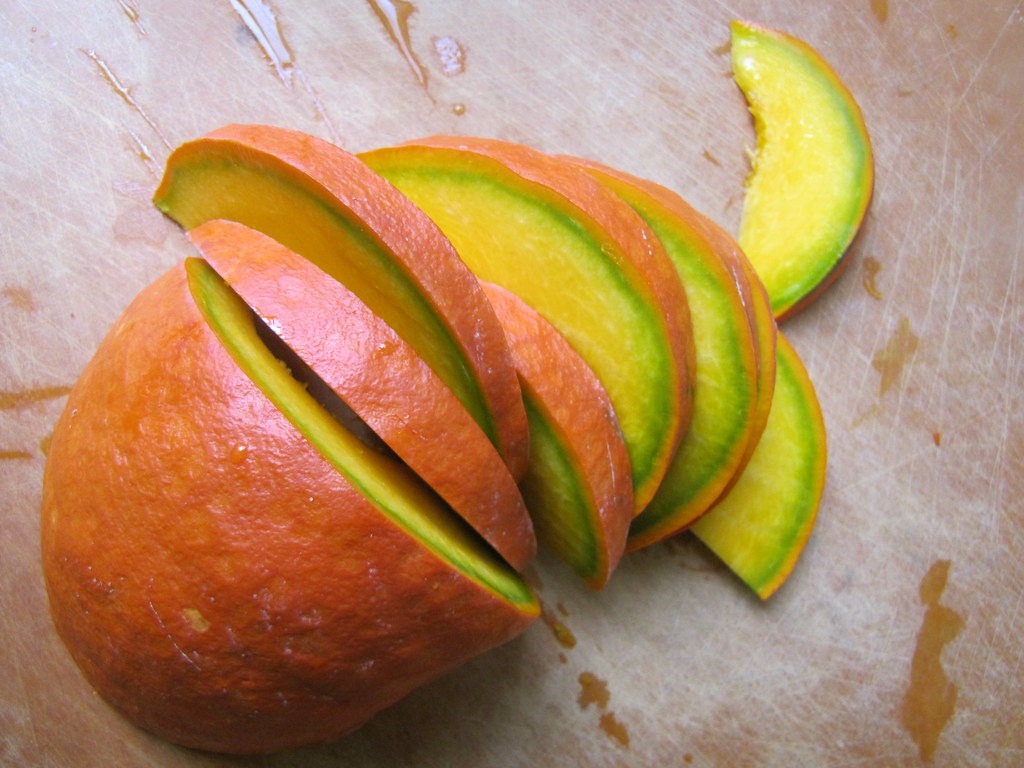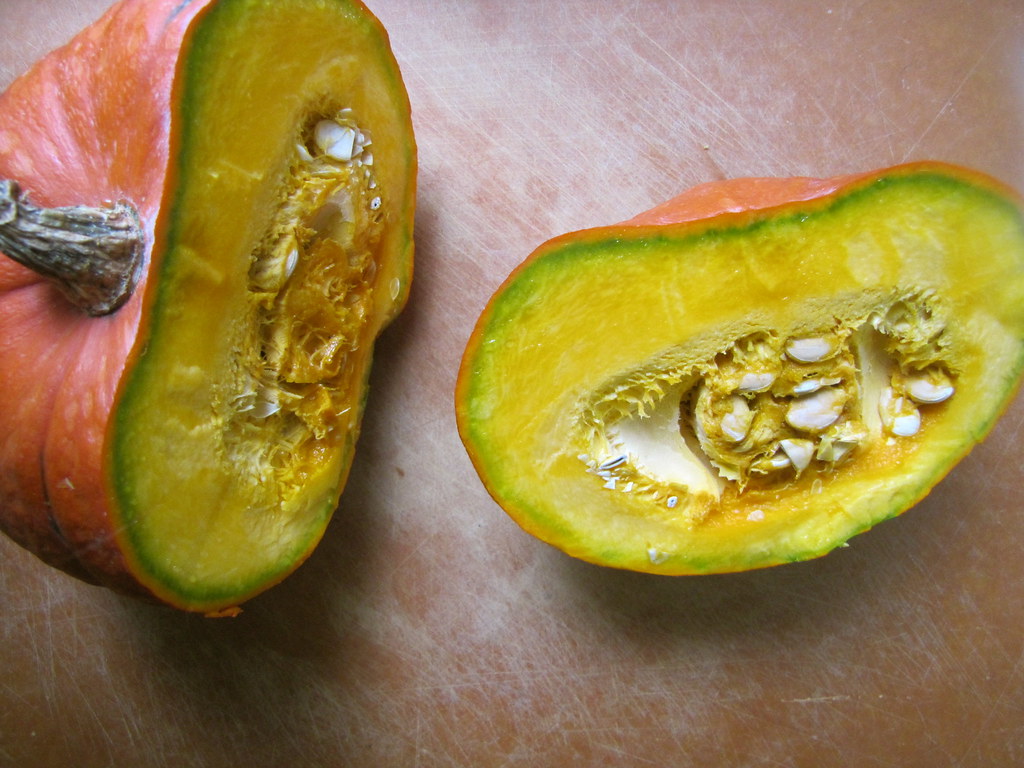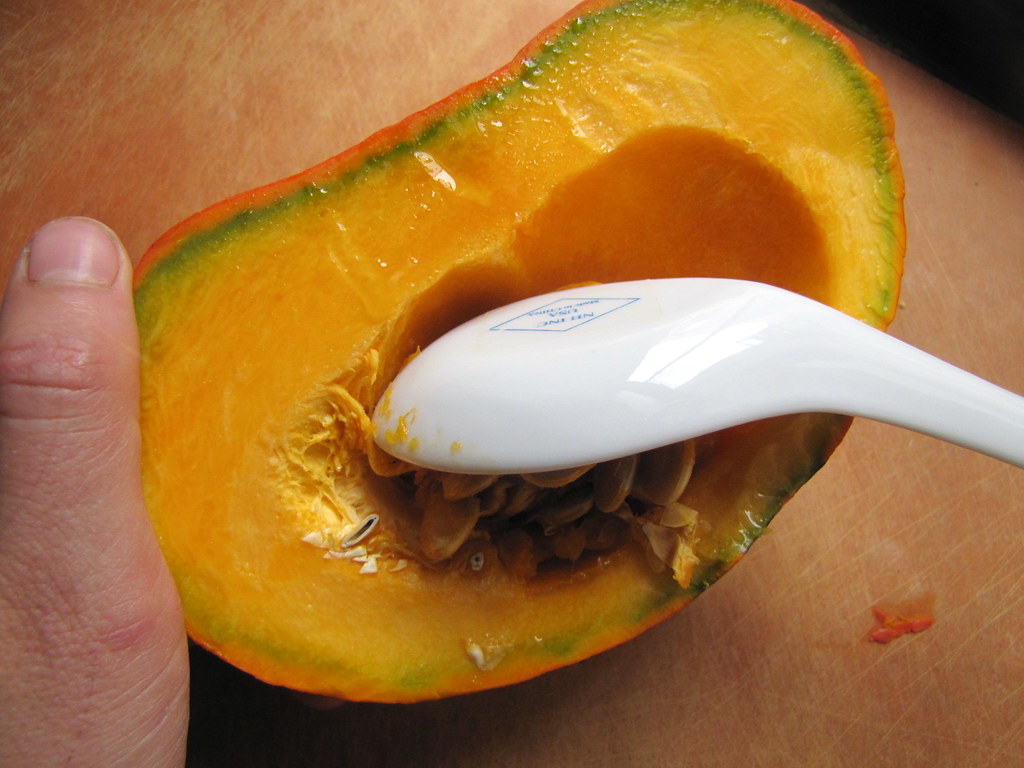Winter squashes can seem intimidating to cook. They have thick, hardened skins often scuffed with dirt, and their dense flesh can make for quite a dangerous job of cutting it if you’re not careful with a big knife. Their seed pockets are stringy and stick to your fingers. They take a long time to soften — or do they? Not when using these red kuri squashes, in thin slices for instance.
These deep-orange colored squashes are among the best for cooking in my opinion. Vibrant and wrinkly on their especially hard surfaces, the flesh once cooked is extremely creamy and flavorful. The kuri squash is similar to kabocha, or “Japanese pumpkin,” and like it, its skin can be left on. This is perhaps its greatest benefit of all, because it eliminates much fuss and wrangling with a knife or heavy-duty peeler.
 two heirloom squash finds: red kuri (bottom) and something that reminds of a dinosaur
two heirloom squash finds: red kuri (bottom) and something that reminds of a dinosaur
The most taxing part of this easy recipe is simply halving the squash from the get-go. Avoid the thick, fibrous stem and slice right through it from top to bottom, with a steady grip. Now, you can slice it up into small wedges, just like a cantaloupe, but beforehand, scoop away the bothersome seeds.
I recommend the Chinese soup spoon as the optimal instrument for this process; the rounded, ceramic edge makes for clean scrapes and easy disposal of the seeds. (While they can be rinsed and roasted, I find that the seeds from kabocha and kuri squash are really huge and leathery, so not too great once crisped in an oven like with pumpkin or butternut squash seeds.)
 try a Chinese soup spoon to scoop out the seeds, and think of a cantaloupe when slicing
try a Chinese soup spoon to scoop out the seeds, and think of a cantaloupe when slicing
It’s easy to create an appealing Maillard-reaction crisp on the broad sides of the squash wedges while cooking them through. When sliced to about half an inch thick each, they need no additional liquids or covering for the flesh to cook through. I scattered some large slices of red onion on the pan once the bottom sides of the squash were browned and flipped. It’s kind of like pan-roasting a nice steak, only with less grease splattering from the pan.
 browning in a dry pan until golden-crisp
browning in a dry pan until golden-crisp
And once topped with a fried egg, it was kind of like steak and eggs, but more fall-like and, well, healthy. You’ve got an egg for protein and richness anyway, so why not pair that with a vegetable instead? With crispy, salty, browned edges and sweet, soft interiors, each bite of the squash was impressively flavorful, for a plant. And the runny egg yolk glazed over the pieces provided a luscious, breakfasty boost.
Next time you see these unique squashes at the farmers market, hope you have a hearty and healthy simple meal with their “steaks.”
Red Kuri Squash “Steaks” and Eggs
(makes 4 servings)
one roughly 2 lb red kuri squash (or substitute kabocha squash)
4 eggs
1 large red onion, halved and sliced thickly
handful fresh mint leaves
3-4 tablespoons extra-virgin olive oil
salt and pepper to taste
Halve the squash lengthwise, avoiding its thick stem. Scoop out the seed pocket with a spoon until all the stringy orange stuff is scraped clean. Slice into 1/2″ thick slices (like a cantaloupe).
Working in batches, heat a heavy-bottomed skillet with 1-2 tablespoons of oil over medium-high. Arrange as many squash wedges as will fit on the pan without overlapping and don’t move them for a minute or so. Sprinkle with salt and pepper. Peek at the bottoms, and once sufficiently browned (after 2 minutes or so), flip each one over. Scatter the red onion slices on the pan so that they get some contact with the surface as well. Sprinkle with salt and pepper. After 2-3 more minutes, taste the squash to see if the thickest parts are softened. If so, remove from the pan.
Heat another tablespoon of oil on the pan and crack a couple of eggs at a time (working in batches if necessary). Fry until the whites are just cooked through, adding a sprinkle of salt to the surface. Arrange the squash and onion on plates and top each with a fried egg. Garnish with the mint leaves and serve immediately.
Cost Calculator
(for 4 servings)
2 lb kuri squash (at $2/lb): $4.00
1 red onion: $0.50
4 eggs (at $5/dozen): 1.67
handful mint leaves (from windowsill plant): $0.25
salt, pepper, olive oil: $0.25
Total: $6.67
Health Factor![]()
![]()
![]()
Three brownie points: Carb-conscious, you’ll love this one. Kuri squashes are mealy and filling when cooked, so you might not miss the starches in this simple dish at all. They’re also packed with beta-carotene (as if their deep orange color weren’t a giveaway), Vitamin A, Vitamin C, and provide a good plant source of fiber, calcium and potassium. The single egg per serving will add a good drop of protein along with some cholesterol.
Green Factor![]()
![]()
![]()
![]()
![]()
![]()
![]()
![]()
![]()
Nine maple leaves: You don’t have to have a whole cornucopia from the farmers market to make a satisfying seasonal meal. This one squash (and onion, eggs, and handful of mint) was enough for four breakfasts alone. That’s talking local, and cheap (at a little over $2 per serving).



11 Responses
Sara @ The Cozy Herbivore
Yum! Love the idea of caramelizing the “steaks” and using the egg yolk as a sauce. What a simple, delicious dinner this would make!
Joanie Thompson
I really like that you are introducing the idea of
eating squash at breakfast time. We tend to limit our thinking to specific foods at specific meals and that is not right. When better than breakfast when we are most hungry to eat a highly nutritious and super tasty food like kuri squash. Good job.
Here’s one for you:
I put a hunk of kuri or kabocha squash in my induction rice cooker when making rice (brown, red or short white). Squash becomes soft enough to eat the skin with a spoon. Oh so wonderful.
Figs in Salad | What I Bring to the Table
[…] You could, of course, stuff, roast or purée, like other squashes, but I particularly liked one food blogger’s preference for slicing it, skin on, and […]
Plant Eating Dinosaur
Virgin green leaves that have just unfolded and not yet been
toughened by age and the heat of the summer are first class ingredients for’.
Science didn’t discover this until 1864 when “British scientist James Clerk Maxwell suggested that electricity and light waves were two forms of the same thing”.
Now old-style fossil hunters with shovels and microscopes compare notes with molecular biologists using genetic
sequencing to trace modern plant families backward to their origins.
Share family vacation photos, find AOL Travel vacation deals, review your hometown, and play daily travel trivia to win Gather points.
house loans for people with bad credit
What a information of un-ambiguity and preserveness of precious experience about
unexpected emotions.
Maria
Loved it!
Ally
I got a Kuri squash in my CSA and wasn’t sure what to do with it. This was delicious! I’ve often fried sweet potatoes to eat with eggs, but I’ve never thought to do it with larger squash.
Curried Red Kuri Squash {What It Is & How to Cook It} | Hometown Harvest
[…] Kuri Squash “Steaks” & Eggs […]
choi da ga
Thanks for sharing! What width trim did you use here and how did you cut the wood?
dagatructiep79
I discovered your blog thee use of msn.
That is ann extremely smartly written article.
đá gà trực tiếp
What a information of un-ambiguity and preserveness of precious experience about
unexpected emotions.